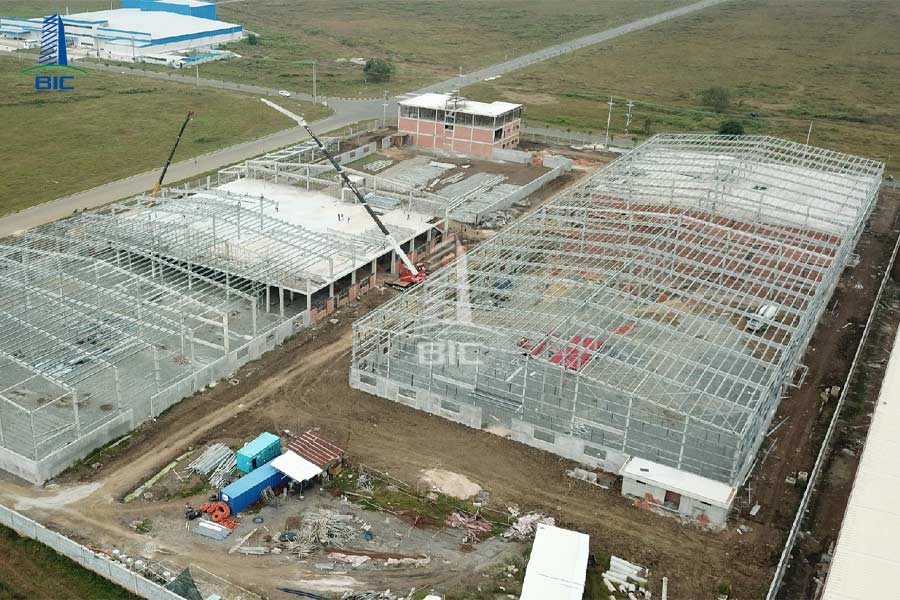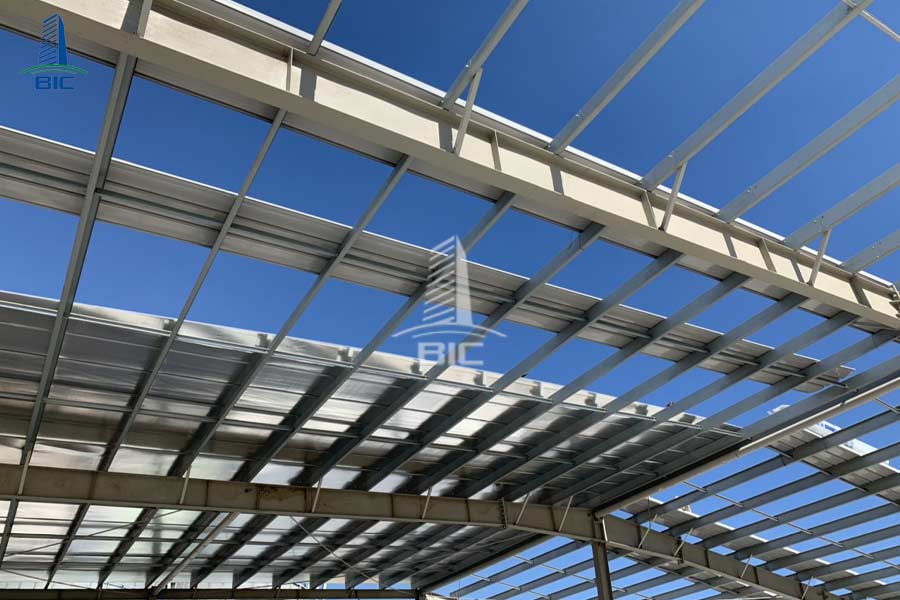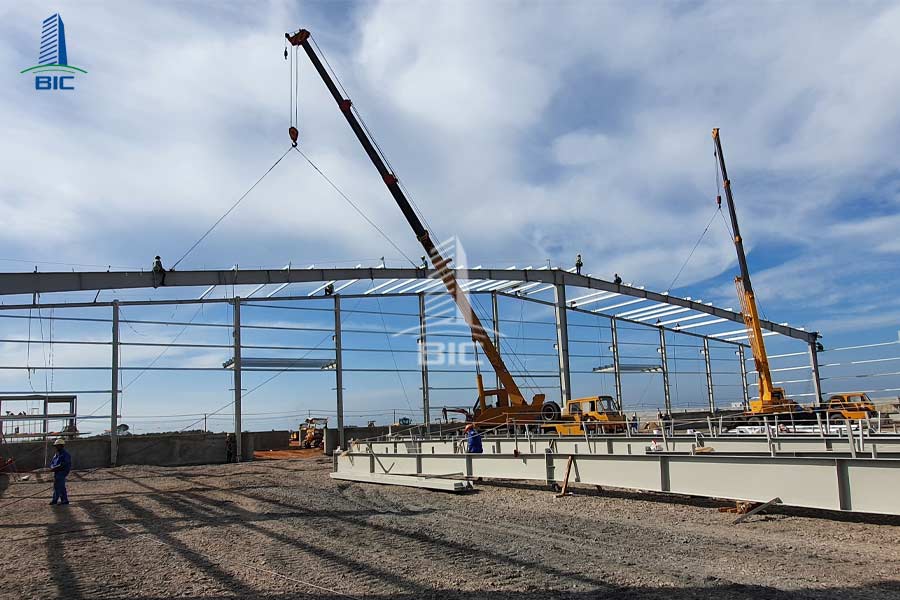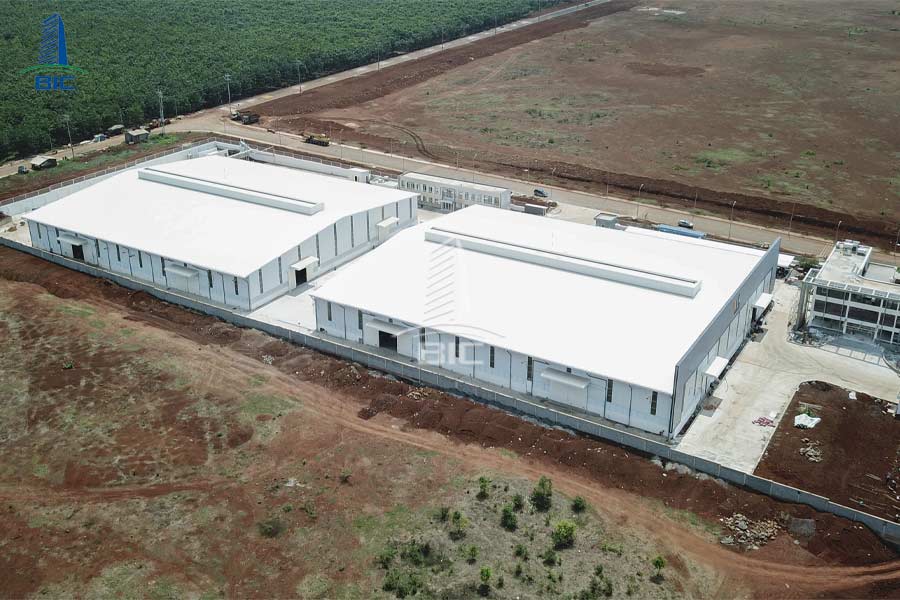
With the rapid development of the industrial and logistics sectors, factory design and construction today demand greater optimization in terms of cost, time, and operational efficiency. Among many available options, steel structure factories have emerged as a preferred solution for businesses due to their flexibility, durability, and adaptability to various production needs.
With a structural steel frame, this type of factory not only shortens construction time but also offers the ability to expand and renovate easily. In this article, BIC will help you understand the definition, outstanding advantages, and practical applications of steel structure factories across different industries.
In modern industrial construction, a steel structure factory is considered an innovative solution that combines advanced fabrication technology with high applicability. It is an industrial building in which the steel frame serves as the main load-bearing system, providing strength and stability while remaining lightweight and flexible.
Unlike conventional concrete construction which requires formwork and curing time, steel structure components are precisely fabricated in factories using specialized machinery and then transported to the site for assembly according to the design drawings. This approach shortens the construction timeline, ensures consistent quality, and minimizes errors.

A standard steel structure factory typically includes:
- Main Frame: Comprising steel columns, rafters, and load-bearing beams. This forms the backbone of the building and supports the entire roof and wall loads.
- Secondary Frame: Includes purlins, bracing, and tie rods which enhance structural rigidity and ensure stability against wind and storms.
- Roof and Wall Panels: Usually made of galvanized steel sheets, insulated panels, or other lightweight materials. Besides protection, these components help with thermal insulation, noise reduction, and aesthetics.
Let’s compare some common types of industrial structures:
Steel Structure vs. Reinforced Concrete Factory:
- Steel structures are much lighter, reducing foundation loads, speeding up construction, and offering easier expansion options.
- Reinforced concrete provides better fire resistance but involves longer construction times and higher labor and material costs.
Pre-engineered Steel Buildings vs. Modular Steel Structures:
- Pre-engineered: All components are manufactured and pre-assembled in the factory, allowing for fast on-site installation.
- Modular: Combines standardized components with custom elements fabricated on-site, suitable for unique or frequently changing designs.
In short, steel frame factories are an ideal choice for businesses seeking a strong, flexible, and cost-effective structure suitable for everything from production and processing to storage.

Compared to traditional construction methods, steel structure factories offer numerous superior advantages for modern factory design and construction. These benefits have made them a top choice for many businesses.
All components are pre-fabricated in the factory using high-precision technology. Once delivered to the construction site, they are assembled directly according to the design without waiting for curing like concrete.
This process can reduce construction time by 30–50% compared to conventional methods, enabling businesses to start operations sooner and recover capital faster.
Steel structure construction reduces labor, formwork, and other complex steps. Since steel is lighter than concrete, foundation loads are lower cutting costs significantly on foundation work, one of the most expensive aspects of construction.
In addition, the fast installation process minimizes indirect costs such as temporary site rental, material storage, and site management.
Steel frame factories are designed to handle heavy loads, resist wind and earthquakes, and remain safe in harsh weather. They can span large areas (30–100 meters) without intermediate columns, offering spacious layouts that simplify machinery setup and production flow.
With anti-corrosion coatings and protective surface treatments, these structures can last for decades while maintaining structural integrity.

One of the biggest advantages is the flexibility for future expansion. Businesses can easily extend or modify the structure without major disruption to existing operations.
Steel components can also be dismantled and relocated, ideal for companies with short-term land leases or frequently changing production locations.
Thanks to these benefits, steel structure factories are not only technically and financially optimal but also a strategic choice for long-term production planning.
Thanks to their outstanding characteristics, steel structure factories are widely used across various fields production, storage, and even commercial projects. Their flexible design and scalability make them suitable for both small-scale operations and large industrial complexes.
In heavy industries like machinery, metallurgy, and fabrication, or light industries like textiles, food processing, and electronics, steel frame factories are a top choice. Their large open span enables smooth production line layouts without obstruction from interior columns.
Logistics hubs, cold storage, and distribution warehouses often opt for steel structure factories due to their fast build time and design adaptability. Their high ceilings and open spaces facilitate efficient rack systems, conveyors, and forklift operation, optimizing loading and unloading activities.

For high-tech agriculture, steel frame structures are used for greenhouses, processing plants, and large-scale livestock farms. They can withstand harsh weather and are easily upgraded or expanded based on seasonal demands.
Beyond industrial uses, steel structure designs are found in exhibition centers, indoor stadiums, large auto garages, and more. The steel frame provides wide, open interiors and allows flexible interior design.
Steel structure factories have proven their versatility and importance across many industries, making them a strategic construction solution in today's fast-changing market.
To ensure durability, functionality, and cost-effectiveness, the construction of a steel structure factory must follow a professional design and execution process. This not only shortens timelines but also minimizes risk and cost overruns.
The engineering team surveys the topography, soil, climate, and legal requirements. This data helps define a design solution that aligns with the business sector, land size, and budget.
Once a concept is agreed upon, engineers develop detailed plans, including the steel frame design, layout, utility systems, and material specifications. These drawings ensure functionality, durability, and aesthetics, while minimizing material waste.

Steel components are fabricated in the factory using cutting, welding, drilling, galvanizing, or anti-rust coating technologies. This guarantees high precision and consistent quality.
Components are transported to the construction site and assembled according to the design. Since they are pre-made, installation is clean, fast, and safe, with minimal dust and noise.
The final stage includes roofing, doors, wall cladding, surface coating, and the installation of electrical, lighting, fire protection, and ventilation systems. After quality checks and acceptance, the facility is handed over for use.
With a standardized and well-managed process, steel structure factory construction ensures quality, speed, and long-term operational performance.
Steel structure factories are a modern construction solution offering numerous benefits: fast build time, cost savings, weather resistance, and flexible future expansion. These advantages have made them a top choice across many industries from manufacturing and processing to logistics and commercial use.
To fully realize the value and longevity of your factory, businesses should work with a professional design and construction firm experienced in end-to-end project delivery from site survey and design to fabrication and construction. This ensures not only quality and timelines but also optimal investment and operational efficiency.
Contact BIC today for expert consultation, a free quote, and the best solution for your steel structure factory project.